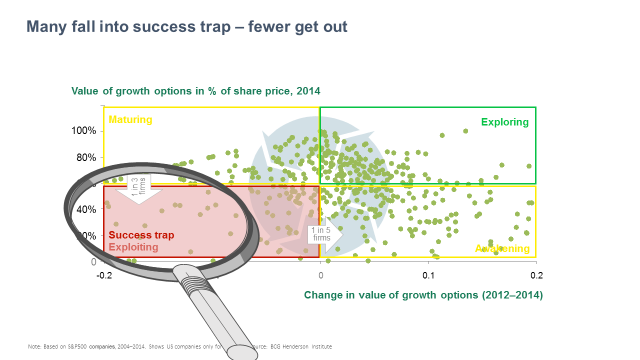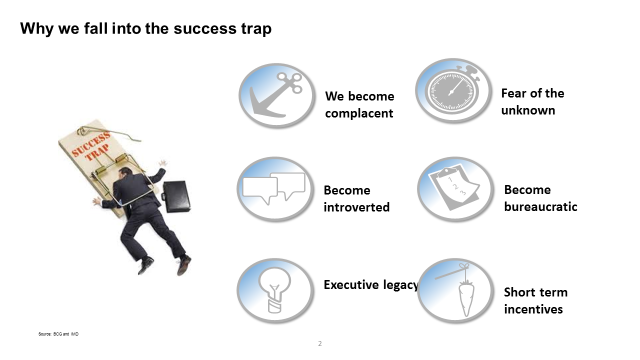The hardest type of corporate renewal, by far, is that of transforming the successful firm. Despite the fact that we live in times of fast change and frequent competitive and technological disruption, many successful firms are unable to change in spite of fully knowing that current recipes won’t cut it a few years down the line.
Recent business history is full of stories testifying to the risks of success. Why did Kodak fail to navigate digital disruption in spite of actively planning for it, while Fuji managed to navigate into new businesses? Why did Blockbuster stick to the old video rental model while Netflix went with new self-disrupting delivery models? Why did both Blackberry and Nokia fail to capitalize on their incumbent positions by becoming smartphone leaders when it was the obvious next step?
These firms in different ways fell into the success trap. In the near future many current industry leaders will be faced with precisely the same challenge.
The challenge of the success trap
The success trap implies too much exploitation, in other words being too satisfied for too long with the returns on using present knowledge, products and technologies. Current success tempts firms to continue using today’s recipes at the expense of exploring for new solutions. Blackberry stuck with what worked well despite the acknowledged need for change. While smartphones with large touch screen displays emerged, Blackberry seemed more preoccupied with protecting its current position. Actually most big businesses and government organizations relied on their great security, push email and functionality – and their Messenger had even become fashionable among young people. BlackBerry dominated in North America, which was clearly the launch pad for cool new mobile products. They felt like they were in a good place and wanted the world to remain the same… Of course it didn’t. It never does.
For long term success, exploration is necessary. In the short term doing more of the same may not seem risky, but in the medium term not changing is detrimental – and especially during times of disruption. As the Swedish playwright August Strindberg notes in A Dream Play: “What people call success is only preparation for the next failure”.
Let’s look at the data. Along with some colleagues from BCG, I helped quantify the success trap through analyzing a sample of 2500 listed companies. We found that fully one third of firms fall into the success trap during a five year period, and that only one in five manage to escape. In the same study we found that while returns can be sustained in the short term through cost reductions and share buybacks, in the longer term over-exploitation was detrimental to growth, profitability and eventually to survival. In the long run, the best performers are firms that, in addition to being efficient today, explore and create future growth options. This is shown in the figure below.
So why do firms fall into the success trap? And, more importantly, what can they do to avoid or escape the success trap?
Reasons why firms fall into the success trap
The figure below shows some reasons why companies fall into the success trap – all could be classified as “self-inflicted pain”.
Some reasons why forms fall into the success trap:
- One reason is complacency. “We are doing well, why change? We built a successful business model and just want to make good better”. Only exploiting current success is understandable, but very risky. Complacency is built on the hope that the world won’t change.
- Another reason for falling into the success trap is our commitment to current competences. “We are so good that we don’t want to change”. Who wants to move towards something they are less good at?
- Another reason – an even more fundamental one – is that our competences sometimes make us blind. Facit didn’t fully realize the power of the electronic calculator despite using it in their own product development of mechanical calculators!
- There are other reasons for falling into the success trap too, for example current management being stuck with past models of success because that it what made them successful as individuals. Or, current executives may be vulnerable to failure, as Sydney Finkelstein describes in the book “Why Smart Executives Fail”. Do we have sufficient incentives and openness among our top people to change what they built? Or, have we become more blinkered and restricted by the spoils of success, like more people, more structure and a fancy new head office? Linked to that is bureaucracy and organizational complexity, which is usually the antithesis to exploring and adapting to uncertain and changing market needs.
How to avoid the success trap
Understanding why we fall into the success trap can helps us avoid it. For example, we need to ask ourselves constantly whether we have sufficient diversity in management, whether we are too bureaucratic, and whether our competitive advantages are fading, in spite of current performance. These questions are relatively easy. More difficult are the following:
First, do we have the right balance between exploration and exploitation investments in our firm? And, are we dedicating the right amount of time to both? In short, do we have the right balance between the short and the longer term? There are many strategies for finding the right balance, but most firms are not explicit about how that balance will help with running and reinventing the business. Here are three examples of strategies to achieve this balance: First, most good private equity firms take a “freeze time” strategy where exploration needs to pay off in a 3-5 year window. Second, some firms give freedom to employees to explore from the bottom up, like 3M. Or, on the other extreme, venture capital firms who think “win stay/loose shift”, simply do more of what works and cut loss quickly on what doesn’t.
Second, do we have the right aspirations and are we ambitious enough? Are we too satisfied just living on past breakthroughs and not creating the platforms for future success? If we do not set aspirational goals we will tend to encourage people “to not lose” instead of playing “to win”. It is important for firms to set stretch ambitions not to fall prey to complacency.
Third, do we have an organizational platform and a culture for experimentation and exploration? Too much focus on success can produce a fear of failure, so we need to ensure that there is a secure base on which our people dare test out new ideas – and even fail. Another important element for organizational exploration is the network of external linkages and ideas.
Fourth, is our attention sufficiently externally focused? Or have we gradually become too introverted? Do we see ourselves through the eyes of our customers? Do we worry enough about disruptions and are we moving sufficiently on inevitable trends such as digital? Having studied how companies communicate, we find that firms that fall into the success trap tend to use words such as “risk reduction”, “short term performance”, “internal” and “established solutions”, whereas explorers are characterized by terms such as “innovation”, “customers”, “opportunities”, “ecosystems”, “agility” and “disruption”.
Getting out of the success trap
Finally, if we already see that we are in the success trap – how do we get out? The answer is not so different in principle to avoiding falling into the success trap. But it is overlaid with the additional challenges of urgency and the need to free up resources to support not only declining short term performance but also growth and innovation. Moving out of the success trap requires a two-step approach of first driving down cost and complexity and then, once in position to reinvest, stepping up future oriented investments, involving exploration and innovation. In other words, companies need a two-step approach to “transforming” their performance and repositioning themselves for long term success.
Lego from 2003 to today provides a good example of this. In 2003 The Lego Group had a budget deficit of more than USD 200m causing the CEO to be replaced. In the following year large cuts led to almost one thousand layoffs, as well as cuts in other expenditures, disposal of amusement parks and the closing of a factory in Switzerland. This lead to a turnaround of results and in 2011 they were back to profits. Product development took off. The new brand Lego Ninjago became the company’s biggest product introduction ever. 2012 saw a 25% rise in revenue over the previous year. More than half of its profits were now through new product launches such as Lego Friends, Lego Elves and Lego Creator.
Summary
Avoiding the success trap and securing against an uncertain future requires exploration, which is a rational investment if we take a long term perspective. Despite exploration being is easier to drive when we are successful, because we have the resources, the “gravitational pull” of the success trap tends to bind us to the status quo. Leadership needs to force the firm to change before change is necessary, to explore when it is uncomfortable and to reinvent when we have the dangerous lure of running with the present solutions!
Knut Haanaes is an IMD professor of strategy.
Martin Reeves is Senior Partner in The Boston Consulting Group and Director of the BCG Henderson Institute.
They are co-authors of Your Strategy Needs a Strategy.





![We are all activists [Video]](https://www.imd.org/ibyimd/wp-content/uploads/2024/03/IByIMD-BookClub-RELIVE-March28-IbyIMD-FeaturedImage-5x4-1250x1000-1-720x630.png)